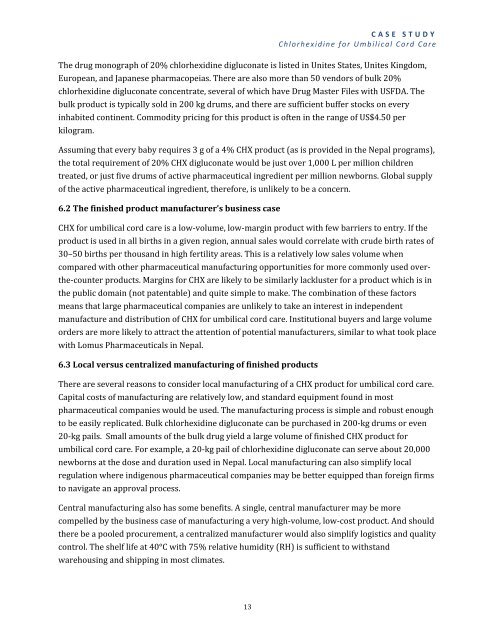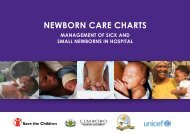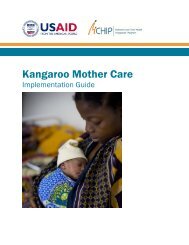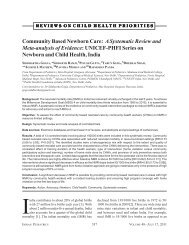Chlorhexidine for Umbilical Cord Care - Healthy Newborn Network
Chlorhexidine for Umbilical Cord Care - Healthy Newborn Network
Chlorhexidine for Umbilical Cord Care - Healthy Newborn Network
- No tags were found...
You also want an ePaper? Increase the reach of your titles
YUMPU automatically turns print PDFs into web optimized ePapers that Google loves.
CASE STUDY<strong>Chlorhexidine</strong> <strong>for</strong> <strong>Umbilical</strong> <strong>Cord</strong> <strong>Care</strong>The drug monograph of 20% chlorhexidine digluconate is listed in Unites States, Unites Kingdom,European, and Japanese pharmacopeias. There are also more than 50 vendors of bulk 20%chlorhexidine digluconate concentrate, several of which have Drug Master Files with USFDA. Thebulk product is typically sold in 200 kg drums, and there are sufficient buffer stocks on everyinhabited continent. Commodity pricing <strong>for</strong> this product is often in the range of US$4.50 perkilogram.Assuming that every baby requires 3 g of a 4% CHX product (as is provided in the Nepal programs),the total requirement of 20% CHX digluconate would be just over 1,000 L per million childrentreated, or just five drums of active pharmaceutical ingredient per million newborns. Global supplyof the active pharmaceutical ingredient, there<strong>for</strong>e, is unlikely to be a concern.6.2 The finished product manufacturer’s business caseCHX <strong>for</strong> umbilical cord care is a low‐volume, low‐margin product with few barriers to entry. If theproduct is used in all births in a given region, annual sales would correlate with crude birth rates of30–50 births per thousand in high fertility areas. This is a relatively low sales volume whencompared with other pharmaceutical manufacturing opportunities <strong>for</strong> more commonly used overthe‐counterproducts. Margins <strong>for</strong> CHX are likely to be similarly lackluster <strong>for</strong> a product which is inthe public domain (not patentable) and quite simple to make. The combination of these factorsmeans that large pharmaceutical companies are unlikely to take an interest in independentmanufacture and distribution of CHX <strong>for</strong> umbilical cord care. Institutional buyers and large volumeorders are more likely to attract the attention of potential manufacturers, similar to what took placewith Lomus Pharmaceuticals in Nepal.6.3 Local versus centralized manufacturing of finished productsThere are several reasons to consider local manufacturing of a CHX product <strong>for</strong> umbilical cord care.Capital costs of manufacturing are relatively low, and standard equipment found in mostpharmaceutical companies would be used. The manufacturing process is simple and robust enoughto be easily replicated. Bulk chlorhexidine digluconate can be purchased in 200‐kg drums or even20‐kg pails. Small amounts of the bulk drug yield a large volume of finished CHX product <strong>for</strong>umbilical cord care. For example, a 20‐kg pail of chlorhexidine digluconate can serve about 20,000newborns at the dose and duration used in Nepal. Local manufacturing can also simplify localregulation where indigenous pharmaceutical companies may be better equipped than <strong>for</strong>eign firmsto navigate an approval process.Central manufacturing also has some benefits. A single, central manufacturer may be morecompelled by the business case of manufacturing a very high‐volume, low‐cost product. And shouldthere be a pooled procurement, a centralized manufacturer would also simplify logistics and qualitycontrol. The shelf life at 40°C with 75% relative humidity (RH) is sufficient to withstandwarehousing and shipping in most climates.13
















